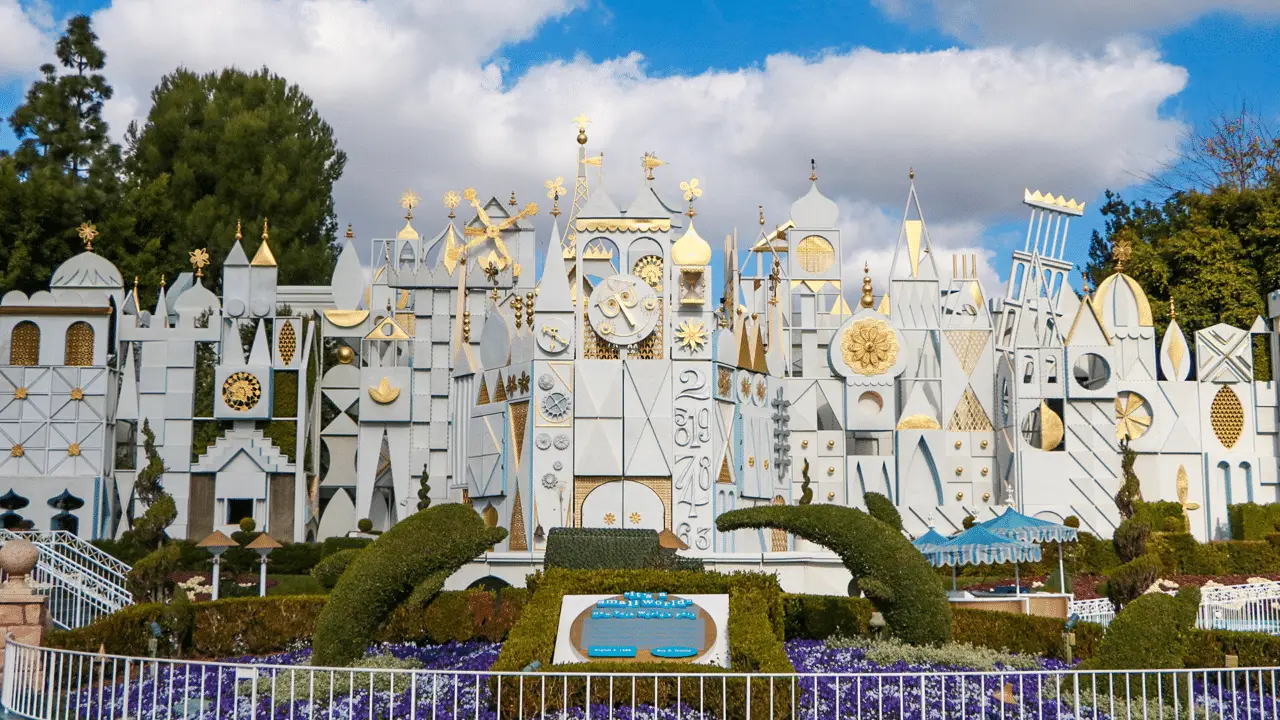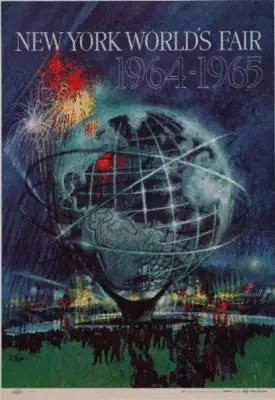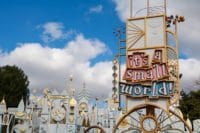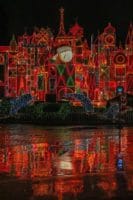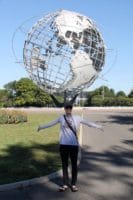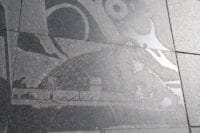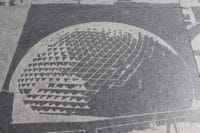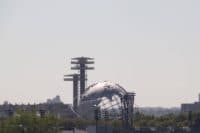Prep for the 1964 World’s Fair
In 1963, WED Enterprises was knee deep in projects; not only for Disneyland, but pavilions for the 1964-1965 World’s Fair in New York. They were working on Great Moments with Mr. Lincoln for the State of Illinois Pavilion, Magic Skyway for Ford, and Carousel of Progress for General Electric. Pepsi-Co approached Disney to create an attraction for their pavilion that would benefit UNICEF.
“Children of the World”
Numerous people told Walt that he should turn it down, but he accepted anyway. The problem here wasn’t just that there were a number of projects underway, but there was a limited time frame. They only had 11 months to design, produce, mock up, ship, and re-assemble an entire attraction. Essentially, everything was stacked against this “little boat ride” as Walt called it, with limited resources, time, staff, and even the fact that the team had to work with an already constructed show building. This was not going to be an easy feat.
Fortunately for Disney, the World’s Fair theme was “Peace Through Understanding”. Walt had an increasing affinity for international cultures and affairs. The working title became “Children of the World”, which helped set the stage for what the attraction would be. Now, Walt needed all of the right people to produce his vision and turn it into reality.
The Design Team
Walt wanted a seasoned designer who he trusted, to which he initially appointed Marc Davis to be the show designer. Davis was known for his comical design approach, but ultimately didn’t quite have the innocence and whimsy Walt was looking for. Walt did, however, have the perfect person in mind for the role. The issue was, she lived in New York and left the Disney Studios over a decade prior. That designer was the legendary Mary Blair. Mary had done concept art for Cinderella, Peter Pan, and Alice in Wonderland, and had the exact style that Walt wanted for this particular attraction. They were able to make it work for her to commute several times over the year from New York to California. She designed the look of the dolls, the sets, and the color palettes. These elements gave the other designers a visual of what to create in three-dimensional form. For the dolls, she designed over 350 different dolls from 26 different countries and regions.
Disney sculptor Blaine Gibson and designer Harriet Burns were tasked to create the dolls based off of Mary’s designs. To make things simpler, given their limited time frame, they made one model of a head that was unisex and simplistic. The heads could be modified with different pigments for different skin tones. Since these dolls were to represent children, they could be made simplistic while enhanced with costuming to showcase their native lands and genders.
This attraction was a huge undertaking for the team, as they were already stretched so thin. Alice Davis, a costumer for film and live-action references for animation, was brought on to create the costumes for the dolls. Mary had already done the design work, so it was up to Alice to bring them to life and costume each of the 350+ dolls as authentically as possible.
Stage One
With many details for the attraction underway, the next part became the actual track itself. Claude Coates was brought in to design the ride layout, as the building had been constructed long before Disney signed on to create the attraction. This meant that they had to work with an L-shaped building and try to make the ride as cohesive as possible with such limited space. A mock up of the attraction was built on Stage 1 at the Disney Studios, and the designers would push Walt around in a boat so he could see how it would look. For the most part, everything was coming together, except for one major component: Walt had wanted the national anthems of the different countries sung by the children. However, once riders moved to the next room, they would hear a cacophony of anthems that didn’t blend. The attraction sounded terrible, much to Walt’s chagrin. That’s when he knew he had to call upon his studio music team, the Sherman Brothers.
“it’s a small world”
Walt wanted a song that was innocent and sweet, appealed to both children and adults, and fit the theme of “Peace Through Understanding”. Still, the idea was to somehow intertwine the countries and regions into the song, all while making it cohesive. The Sherman brothers came up with three songs, the first being, “it’s a small world”. It had a sweet and catchy melody, and the lyrics could be easily translated into other languages for the different regions. It was exactly what Walt had wanted, so the other two songs they wrote didn’t get a chance to be heard. It’s hard to imagine any other tune fitting to this beloved attraction.
To intertwine international flair with the Sherman Brothers tune, Bobby Hammock was brought in to help arrange the song. In order to fit the musicality of the different countries, he added specific instruments and tones from the international regions. The three also created an arrangement that could play in the courtyard outside of the attraction as an overture to the show inside. What’s funny is that the Sherman Brothers didn’t think the song would last longer than the World’s Fair. Little did they know…
The Tower of the Four Winds
When it comes to Disney attractions, there is always a marquee of some sort, that acts as a way for guests to know what attraction they’re going to experience before even getting in line. While the World’s Fair wasn’t exactly Disneyland, the team knew that they needed some sort of visual marquee to draw guests in. “it’s a small world” was tucked away in a corner, so Walt enlisted Rolly Crump to design a sculpture for people to see. The end result was the Tower of the Four Winds, a 120 foot structure. It was bright and had dozens of moving pieces to represent the spirit of children. Unfortunately, Rolly’s design was altered, as the builders constructed it to withstand any weather. Rolly was disappointed, to say the least, but Walt still loved it, and it truly was an incredible feat that stood out at the World’s Fair.

The World’s Fair
“it’s a small world” wound up being a HUGE success and was very well received. It drew in around 40,000 attendees a day, which was incredible as it was a paid admission at the fair. It was one of the most popular attractions and estimated hosting 10 million guests during its two seasons. Seeing that the attraction was successful from the beginning, Walt ultimately decided it would find a permanent home in Disneyland. Construction started on the show building in the northeast corner of Fantasyland in 1965. Once the fair was over, the set pieces and figures could be shipped and then installed permanently.
“it’s a small world” Gets Ready for Disneyland
With this new attraction heading to Disneyland, Walt again wanted a visual marquee for “it’s a small world”. This time, however, would be a façade that showcased the whimsy of what guests would experience inside. Walt again enlisted Mary Blair to design it. However, it proved to be difficult for Mary to fully conceptualize what it would look like. Mary worked in two-dimensional and water color, but couldn’t quite comprehend how to make it look three-dimensional. Rolly Crump was brought back in to help bring Mary’s ideas to life. He designed the façade that we all know and love.
Walt had hoped that the Tower of the Four Winds would be able to make its way back to Disneyland. However, Rolly thought it would block this incredible new design and the clock face tower. Surprisingly, Walt agreed that the clock tower would signify as a great replacement as the focal point, and the Tower of the Four Winds remained in New York. It ultimately would have cost thousands of dollars to move it, and was sadly destroyed.

“it’s a small world” Opens at Disneyland
“it’s a small world” opened on May 28th, 1966 with international fanfare. Representatives from a number of countries, as well as members of the press, were on hand to celebrate the occasion. Children from 16 regions were also there and poured water from the “seven seas and nine major lagoons” into the waterway of “it’s a small world”.

Changes Over the Years
While the attraction itself has seen minimal changes over the years, the façade itself has actually seen the most change. It started as gold and white, was painted pastel, then white and blue, and then back to white and gold. These are some photos of “it’s a small world” from earlier this year.
In 1997, a holiday overlay was added and “it’s a small world” Holiday has happened every year since. The façade is adorned with a million lights, while the entire inside of the attraction is decorated with lights, Christmas décor, and each doll is given a themed adornment. In 2019, the addition of holiday scents was added to three scenes in the attraction.
2008 brought an interesting change, as the attraction included the addition of 29 Disney characters in their respective countries. In 2011, Disney started utilizing projection mapping on “it’s a small world” for nighttime entertainment, with the first show, “The Magic, the Memories, and You”. Disneyland has utilized the attraction façade for nighttime projections ever since.
This attraction holds a very special place in my heart. I fell in love with the whimsy and aesthetic of the attraction. While some may find it annoying, the song and attraction are a beautiful representation of hope and peace. Often times, I’ll go to the park, grab Starbucks or lunch, and sit across from the attraction and just enjoy the music and the clock parade. Not only that, but “it’s a small world” and I also share a birthday, which makes it even more special.
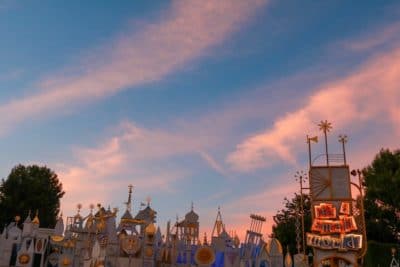
The World’s Fair Location Now
A few years ago, I had the chance to visit Flushing Meadows Corona Park, the location of the 1964-65 World’s Fair. Almost everything is gone, but the Unisphere, remnants of the New York Pavilion, and plaques can still be found on the grounds. Enjoy these photos from the location that holds a huge place in Disney history.
Check out these sites for more information on Disney’s involvement in the 1964-65 World’s Fair: Designing Disney

